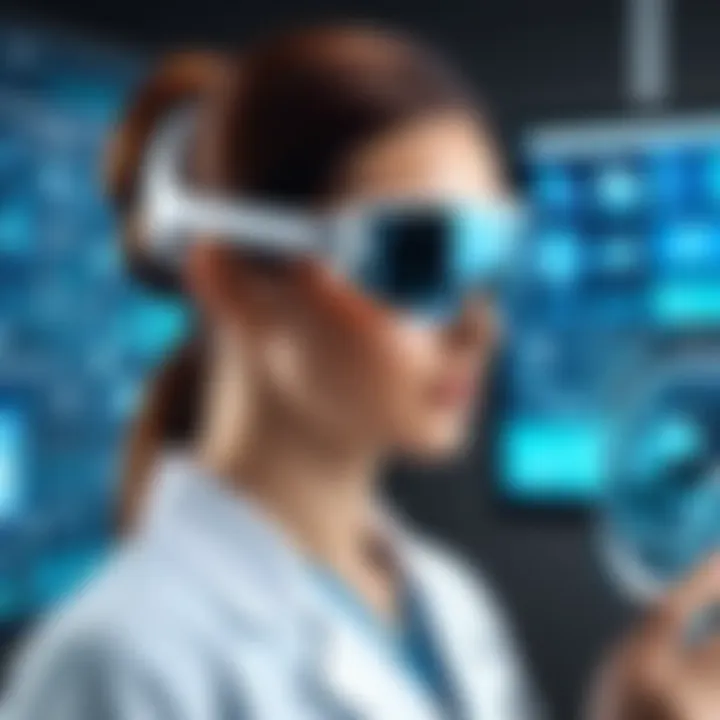The Transformative Impact of Augmented Reality in Industry


Intro
The discussion surrounding augmented reality (AR) has gained substantial traction in recent years. This technology is no longer confined to gaming or entertainment. Instead, it is now pervading numerous sectors, promising to enhance efficiency and productivity. In this article, we will explore the diverse applications of AR in various industries. We will also highlight the challenges faced in implementation, examine real-world case studies, and discuss the future trajectory of AR technology.
Brief Description
Overview of the software
Augmented reality software layers digital information onto the real world. This can be consumer-focused, like mobile apps for entertainment, or enterprise-centric, such as tools for training or maintenance in manufacturing and healthcare settings. Notably, Google ARCore and Apple ARKit stand out as two pioneering platforms enabling developers to create customized AR experiences.
Key features and functionalities
AR software provides a range of features that cater to different needs:
- Real-time interactions: Users can interact with digital content in real time.
- 3D Visualization: Information is not limited to 2D, allowing for a more immersive experience.
- Geolocation: AR can supply context-aware information depending on a user's physical location.
- Integration with existing systems: Many AR applications can seamlessly work with existing enterprise software, enhancing their utility.
These functionalities empower industries to advance processes and training significantly.
System Requirements
Hardware requirements
Implementing AR technology often requires specific hardware capabilities. Essential components include:
- Adequate processing power, often found in devices such as smartphones or tablets.
- Cameras that capture real-world environments accurately.
- Sensors for enabling motion tracking and environmental recognition.
For specialized applications, dedicated AR glasses such as Microsoft HoloLens or Magic Leap One might be utilized, providing an enhanced immersive experience.
Software compatibility
AR solutions need to be compatible with various operating systems. Common platforms supporting AR include:
- iOS: Supported by Apple ARKit.
- Android: Utilizes Google ARCore.
- Windows: Especially for integrated AR systems like HoloLens.
Ensuring compatibility with existing frameworks is crucial to streamline operations and minimize disruptions.
AR technology not only adds visual information but also enhances overall operational efficiency in multiple sectors.
With a better understanding of what AR entails, we can now proceed to explore its applications in specific industries.
Foreword to Augmented Reality in Industry
Augmented reality (AR) represents a significant technological advancement with vast implications across multiple sectors. Its importance lies not only in enhancing visual information but also in bridging the gap between the physical and digital realms. This article explores how AR interfaces with various industries, offering substantial benefits while presenting specific considerations.
AR integrates digital elements into the real world, which can streamline processes, enhance training methodologies, and improve user engagement. From manufacturing to healthcare, this technology facilitates operational efficiency and fosters innovative problem-solving capabilities. Businesses that adopt AR are also likely to see a competitive advantage.
AR enhances productivity by providing immediate access to information and visual guidance, which is crucial in domains such as product design and prototyping. Companies employing AR can improve their design iterations, thus reducing time to market.
Overall, exploring the role of AR across industries is essential to understand its transformative potential. The following sections delve into its definition, historical context, and prominence in various fields.
Definition and Overview of Augmented Reality
Augmented reality is defined as a technology that overlays digital information onto the physical world. Unlike virtual reality, which immerses users in a completely digital environment, AR enhances the real world with the addition of virtual elements. This interaction can occur through devices such as smartphones, tablets, and AR glasses.
The core components of AR include hardware, which involves cameras and sensors; software that processes information; and user interfaces that display the augmented features. The technology operates by recognizing physical objects and environments, allowing for dynamic and context-specific content display.
In practical terms, AR facilitates interactive experiences that are applicable in various fields, from gaming to industrial applications. For example, workers in manufacturing can visualize assembly instructions in real-time, improving efficiency.
Historical Evolution of Augmented Reality Technologies
The evolution of augmented reality technology dates back to the 1960s with the Sensorama, a multi-sensory simulator that combined various media. However, modern AR began to take shape in the 1990s with seminal works by Louis Rosenberg, who created the first fully functional AR system known as Virtual Fixtures.
In the early 2000s, AR started catching the attention of industries. Military applications saw initial implementations, such as heads-up displays in fighter jets. As smartphone technology advanced, AR became more accessible. Applications like Google Glass and later, smartphone apps such as Pokémon Go, popularized AR in consumer markets.
Today, AR technology continues to innovate and expand in scope, making its way into industries like education, healthcare, and retail. Integration with artificial intelligence has further enriched AR capabilities, offering personalized experiences that adapt to user behavior.
"Augmented reality is not just a novelty; it is a tool that has the potential to change the way we interact with our environment."
The historical trajectory of AR signifies its growing relevance, underscoring the necessity of understanding its applications and potential impact within the industry.


Applications of Augmented Reality in Manufacturing
The integration of augmented reality in the manufacturing industry represents a significant leap forward in both productivity and efficiency. By overlaying digital information on physical environments, AR enhances the capabilities of workers and streamlines complex processes. As industries strive for higher accuracy and reduced costs, the role of AR becomes increasingly consequential.
The applications of augmented reality in manufacturing can be categorized into several core areas, each contributing uniquely to operational improvements.
AR in Product Design and Prototyping
In the early stages of product development, augmented reality facilitates faster and more effective design processes. Designers can visualize their concepts in 3D within the physical workspace. This immediate feedback loop allows for iterative design modifications with minimal physical prototyping required.
Some benefits of AR in product design include:
- Enhanced Collaboration: Teams can work together in a shared AR space, allowing for real-time input and brainstorming, often across various geographic locations.
- Reduced Development Time: Instant visualization of designs can significantly shorten lengthy approval processes.
- Cost Efficiency: By minimizing the need for physical prototypes, companies can save on materials and reduce waste.
Additionally, tools like Autodesk’s Fusion 360 provide a platform for AR-enhanced design, making it easier to incorporate changes based on feedback dynamically.
Training and Skill Development through AR
Training employees in manufacturing settings can be resource-intensive. However, using augmented reality can change that landscape. AR offers a hands-on training experience without the risks associated with actual machinery operation.
Potential advantages of AR-based training include:
- Increased Engagement: Interactive learning modules cater to diverse learning styles, often resulting in better retention of information.
- Safety Improvements: Training in a controlled digital environment allows employees to practice skills without the danger of accidental injury.
- Consistent Training Delivery: AR ensures that every employee receives the same level of training, resulting in uniformity in skill development.
For example, Boeing has successfully implemented AR to guide assembly workers through complex aircraft assembly processes, proving the effectiveness of this method.
Maintenance and Repair Support via AR Tools
Another crucial application of augmented reality in manufacturing lies in maintenance and repair. AR tools can provide technicians with real-time information and visual guidance, enhancing their efficacy on the job.
Key aspects of using AR in maintenance include:
- Real-Time Guidance: AR can overlay step-by-step instructions on machinery, assisting technicians in identifying issues and performing necessary repairs without extensive manuals.
- Remote Assistance: Experts can guide on-site technicians through AR applications, allowing for effective troubleshooting without needing to be present.
- Reduced Downtime: Quick access to information enables faster repairs, minimizing disruptions in production.
For instance, companies like Volkswagen are using AR glasses that display repair instructions directly onto the machinery, ensuring technicians make informed decisions promptly.
In summary, the applications of augmented reality in manufacturing reveal its transformative potential. As technologies advance and user acceptance grows, AR is set to redefine how products are designed, how employees are trained, and how maintenance is approached.
"Augmented reality holds the potential to drive unprecedented levels of efficiency and quality within manufacturing environments."
Healthcare Use Cases for Augmented Reality
The integration of augmented reality (AR) in healthcare is becoming increasingly significant. This technology offers novel solutions that enhance medical procedures, improve patient outcomes, and facilitate learning among medical professionals. The advancement of AR in healthcare not only streamlines the workflow but also improves the accuracy and efficacy of various medical practices. As the industry evolves, understanding how AR can be applied in real-world scenarios is essential.
Surgical Assistance and Visualization
Surgical assistance utilizing augmented reality is one of the most groundbreaking applications in modern medicine. Surgeons can overlay crucial information directly onto the patient's body during the procedure. For example, AR tools such as Microsoft's HoloLens are used to provide a 3D visualization of a patient’s anatomy, helping doctors plan and execute complex operations with greater precision.
Such applications allow for:
- Enhanced Visualization: Surgeons can view critical structures without needing to make large incisions. This leads to less invasive surgeries and reduces recovery time.
- Improved Accuracy: Overlaying digital imaging data like MRI and CT scans directly onto the surgical field offers clarity.
- Real-Time Data Access: Access to live data during a procedure helps in making informed decisions quickly.
This level of detail can significantly minimize risks and impact surgical outcomes positively.
Patient Education Enhancement through AR
Education plays a crucial role in patient care. Augmented reality can drastically improve how patients understand their own medical conditions and treatment plans. Interactive 3D models can illustrate complex medical concepts, diseases, or the processes involved in various therapies.
Consider the following benefits:
- In-depth Understanding: Patients can visualize their anatomy and the effects of a condition on their health, which fosters better comprehension of their diagnosis.
- Engagement: By interacting with AR models, patients are more likely to engage in discussions about their care, resulting in better communication with healthcare professionals.
- Customized Learning: Tailoring educational experiences using AR can cater to individual patient needs and preferences, enhancing their overall experience.
"AR in healthcare not only promotes knowledge but also empowers patients to take an active role in their health management."
As AR continues to develop, its influence on the healthcare sector is likely to expand, paving the way for improved procedural outcomes and enhanced patient understanding.
Augmented Reality in Education and Training
Augmented reality plays a significant role in education and training, reshaping traditional methodologies. The integration of AR technology creates a more engaging learning experience. Students can interact with educational materials in a way that enhances comprehension and retention of knowledge. This can lead to improved performance in various disciplines.
Key benefits of augmented reality in education include:


- Enhanced Visualization: Complex concepts, such as biological processes or mathematical models, become more accessible. Students can visualize and manipulate 3D models, making learning more tangible.
- Increased Engagement: AR introduces elements of gamification, which can boost student motivation. As learners interact with dynamic content, their curiosity and interest in subjects increase.
- Flexible Learning: With AR, education is not limited to the classroom. Students can learn in different environments, using their smartphones or tablets to access information virtually anywhere.
Considerations such as cost and technical skills required for effective implementation must be analyzed. Schools will need adequate resources to procure AR tools and train educators.
Interactive Learning Environments with AR
Creating interactive learning environments is one of the primary focuses of augmented reality in education. This technology can transform a standard classroom into an immersive space. For example, using AR applications, students can explore historical sites or scientific phenomena in real-time.
AR allows for:
- Real-time Interaction: Learners can engage with digital components that overlay physical environments. This interaction fosters deeper understanding of lessons by linking theory to practice.
- Collaborative Activities: Students can work together on projects within an AR framework, learning from each other. This interaction promotes skills that are essential for future workplace scenarios.
Collaborative Projects Utilizing AR Technologies
AR also excels in enabling collaborative projects. When students work together using augmented reality, they can bring creativity and innovation into their work. Each participant can contribute through shared immersive experiences.
Benefits of collaborative AR projects involve:
- Teamwork Development: Students learn to communicate effectively and work towards common goals while navigating project challenges.
- Diverse Perspectives: Collaborative efforts allow students to combine different viewpoints, enriching their learning experience.
In this digital age, embracing AR in educational settings is crucial for fostering a generation that thrives on technological adaptation and innovation.
While challenges exist, such as ensuring that all students have access to the necessary devices, the potential that augmented reality holds in education is vast. As institutions adopt this technology, they can prepare students for a future where digital and physical landscapes blend seamlessly.
Impact of Augmented Reality on Retail
Augmented Reality (AR) has significantly influenced the retail sector, reshaping customer interactions and engagement. The use of AR provides retailers with innovative tools that enhance the shopping experience, leading to better customer satisfaction and increased sales. The integration of AR can create immersive experiences that allow consumers to visualize products in a more tangible way, impacting their buying decisions positively. This relevance emphasizes AR's role in not only attracting but also retaining customers in a competitive market.
Enhancing Customer Experience through AR
AR technology has changed how consumers interact with products before making a purchase. Through applications and tools, retailers can offer virtual fitting rooms, allowing customers to try on clothes or accessories without physically wearing them. This feature saves time and enhances convenience for shoppers.
Additionally, AR can provide product information directly in the shopping environment. For example, customers can use their smartphones to scan products and access detailed specs, user reviews, or tutorial videos. This transparency builds trust and fosters informed purchasing decisions. The personalized interaction AR offers creates a deeper connection between the consumer and the brand, which can result in increased loyalty.
According to recent studies, retailers that implement AR technologies can see up to a 40% increase in conversion rates as customers engage more deeply with the products on offer.
Other benefits of enhancing customer experience through AR include:
- Personalized Shopping: Tailored recommendations based on user preferences and behavior
- Interactive Promotions: Engaging marketing strategies that captivate potential buyers
- Increased Engagement: Keeping customers interested and involved throughout their shopping journey.
Virtual Trials and Product Demos
Virtual trials represent one of the most compelling applications of AR in retail. Customers can visualize how furniture fits in their home or see how makeup looks on their skin. Companies like IKEA use AR to allow customers to place 3D models of furniture in their living spaces, helping to bridge the gap between online and in-store shopping experiences.
On the other hand, product demos give customers the chance to explore products in a safe and controlled setting. Retailers can leverage AR to showcase products without the need for physical stock. For instance, cosmetic brands often use AR to let customers virtually test various shades of lipstick or foundation.
The benefits of virtual trials and product demos in retail include:
- Reduction in Returns: Accurate visualization helps customers make better-informed choices, reducing return rates.
- Time Efficiency: Customers save time when they can easily access product information and visualizations.
- Increased Sales Opportunity: Engaging customers effectively can lead to impulsive purchasing, enhancing overall sales figures.
Challenges and Limitations of Augmented Reality in Industry
As augmented reality (AR) gains traction across various sectors, understanding its challenges and limitations becomes crucial. While AR offers numerous benefits, these challenges can hinder its implementation and effectiveness. Addressing these issues is essential for companies intending to integrate AR into their operations. It ensures that resources are spent wisely and the right strategies are executed for a successful implementation. This section examines technical constraints and user acceptance challenges that impact the adoption of AR technologies in industry.
Technical Constraints and Integration Issues
Technical challenges pose significant barriers to the integration of augmented reality in industry. Firstly, the hardware required for AR is often costly and may not be accessible for all businesses. High-performance devices, such as Microsoft HoloLens or Magic Leap, can require substantial investment. Additionally, not all existing systems can seamlessly integrate with new AR solutions. This can lead to issues such as data compatibility, which can further complicate the implementation process.
Moreover, the software landscape is still evolving. Many AR applications are in early development stages, resulting in bugs and performance inconsistencies. Companies may face difficulties in customizing these applications to meet their specific needs. The learning curve may also be steep, requiring staff to undergo training programs before deployment.
AR systems depend heavily on robust connectivity and processing power. In environments where high-speed internet is not available, the AR experience can suffer, leading to delays and poor performance. Furthermore, certain industries operate in remote areas where technological infrastructure is limited, complicating the AR adoption process.
User Acceptance and Adaptation Challenges
Despite the technological advancements, user acceptance remains a significant hurdle. Employees may resist adopting AR for several reasons. Some individuals may feel overwhelmed by the technology and believe it complicates their tasks rather than simplifying them. The perception of AR as a gimmick rather than a valuable tool can contribute to this reluctance.
Training is a vital component in overcoming these challenges. Organizations need to invest time and resources to educate their staff about the benefits of AR and how to effectively use it. If employees do not understand how AR enhances their work, they may disengage from the technology. This disconnect can lead to inconsistent usage and reduced return on investment.
Additionally, there are economic concerns. Employees may worry about job security, fearing that automation through AR could lead to job loss. Management must address these fears transparently, illustrating how AR can serve as a complement to human effort rather than a replacement.
"The success of augmented reality in any industry hinges not just on technology, but on people’s willingness to embrace it."


Finally, organizational culture plays a crucial role in AR adoption. An open and innovative culture encourages the exploration of new tools and technologies. Without such a culture in place, the integration of AR could face substantial resistance, as teams may prefer to stick to familiar processes and tools.
Case Studies of Augmented Reality Implementations
Case studies provide a tangible understanding of how augmented reality is integrated into various industries. They illustrate practical applications, demonstrating the effectiveness of AR technologies and the challenges faced during their implementation. Analyzing these cases offers insights into best practices and innovative strategies that can be applied across different sectors. Moreover, successful implementations serve as benchmarks for other organizations aiming to adopt similar technologies, making this topic crucial for understanding the broader impact of AR in industry.
Successful AR Deployments in Manufacturing
In the manufacturing sector, augmented reality has transformed traditional processes significantly. One notable example is Boeing, which utilizes AR to assist workers in assembling complex aircraft parts. Through the use of Microsoft HoloLens, technicians can access real-time data and visual guidance directly in their line of sight. This hands-free approach improves accuracy and efficiency, reducing error rates by approximately 40%.
Another remarkable deployment is from Siemens. The company implemented AR in its production lines to facilitate training for new employees. By integrating AR with their existing systems, Siemens allows trainees to experience immersive learning. This hands-on approach enhances understanding and retention of critical information, which ultimately leads to reduced training time and costs.
Key benefits observed from these cases include:
- Increased Efficiency: Workers complete tasks more quickly and accurately.
- Improved Training: New staff gain knowledge faster through interactive experiences.
- Reduction of Errors: Access to visual aids minimizes potential mistakes during assembly.
Innovative Healthcare Facilities Using AR
The healthcare sector also shows promising use cases for augmented reality. An innovative example can be found in the use of AR for surgical planning and assistance in facilities like the Johns Hopkins Hospital. Surgeons utilize AR overlays during operations to visualize critical structures, enabling more precise interventions. This real-time visualization can significantly improve patient outcomes by reducing operation times and minimizing risks associated with complex procedures.
Furthermore, the case of the University of Maryland Medical Center highlights how AR enhances patient education. Medical professionals use AR applications to help patients visualize their surgical procedures. This method demystifies the processes involved, leading to better patient engagement and understanding of their treatment plans.
Some advantages noted in these healthcare implementations include:
- Enhanced Surgical Precision: Surgeons perform with greater accuracy by seeing key anatomical aspects.
- Improved Patient Communication: Visualization tools aid in explaining procedures to patients.
- Increased Safety: Real-time data helps mitigate risks during surgeries, leading to safer outcomes.
Future Trends in Augmented Reality Technology
Augmented reality continues to evolve, with future trends poised to redefine the landscape of various industries. Understanding these trends is critical for professionals looking to leverage AR effectively. As AR technology becomes more integrated into business processes, it presents numerous benefits, but also important considerations.
- Importance of Understanding Future Trends
Being aware of emerging trends allows businesses to stay competitive. It helps in making informed decisions regarding technology investments and operational strategies. Assessing these trends also encourages innovation which can drive growth. - Specific Elements in Future Trends
- Mobile AR: As smartphone technology advances, mobile AR applications will become more common and powerful. This makes AR accessible to a broader audience.
- Wearable Technologies: Devices such as smart glasses and AR contact lenses are under development. These innovations aim to enhance user experience by providing hands-free access to information.
- 5G Connectivity: With the rollout of 5G networks, AR will benefit from faster data transfer rates and lower latency. This will enable smoother user interactions and real-time data processing.
- Artificial Intelligence Integration: Combining AR with AI can enhance customization and contextual relevance. It enables machines to understand environments better and provide tailored experiences.
"The future of AR is not just about better graphics; it’s about smarter interactions that enhance human capabilities and decision-making processes."
Emerging Technologies Driving AR Adoption
Several key technologies are driving the adoption of augmented reality across industries. Recognizing these can help businesses strategize their AR implementations.
- Machine Learning: ML algorithms enhance AR by enabling systems to learn from user behavior and adapt content accordingly. For instance, in retail, personalized AR experiences can be created based on user preferences.
- Internet of Things (IoT): IoT devices can provide data that complements AR applications. For example, in smart manufacturing, AR can present real-time data overlaid on equipment, enhancing decision-making.
- Spatial Computing: Advances in spatial computing enable precise tracking of real-world objects. This is essential for creating immersive AR experiences that are interactive and realistic.
Predictions for Industry-specific AR Innovations
Looking forward, several industry-specific innovations in AR can be expected. These predictions offer a glimpse into how businesses can benefit from enhancements in AR technology.
- Manufacturing: In the near future, AR will likely provide real-time visualizations of production lines, making optimization easier. Workers may use AR glasses to receive instructions, which can reduce errors and enhance efficiency.
- Healthcare: AR is expected to surpass basic visualization. Future applications might include real-time imaging during surgeries. Enhanced patient education tools using AR could also transform care delivery.
- Education: Educational institutions may adopt AR for creating engaging learning experiences. The use of AR for virtual classrooms and hands-on training is likely to increase.
- Retail: Predictive AR shopping experiences are on the horizon. Customers might receive recommendations based on past purchases and preferences, all through an augmented experience.
In summary, tracking these future trends highlights not only the technological advancements but also the shifting operational paradigms across various industries. Adopting these innovations could position businesses ahead of the curve in this rapidly evolving digital age.
Ending: The Lasting Impact of Augmented Reality in Industry
The exploratory journey throughout the landscape of augmented reality (AR) reveals its significant impact on various sectors. As industries continue to adopt AR, understanding its lasting effects is crucial for stakeholders. The role of AR is not just about improving efficiency; it's also about transforming the way organizations operate.
The integration of AR in manufacturing leads to reduced error rates, enhanced productivity, and improved training methods. Sectors like healthcare gain from surgical precision and improved patient interaction. Educational institutions leverage AR for interactive and immersive learning experiences, engaging learners in a way that traditional methods fail to achieve. Retailers also benefit by enhancing shopping experiences, making them more personalized and engaging.
"Augmented reality reshapes industry frameworks, providing innovative solutions that redefine operational capabilities."
Amidst these advantages, there are a few considerations to keep in mind. The success of AR implementations heavily relies on user acceptance and the readiness of existing infrastructure. Moreover, organizations must consider the technical limitations and integration challenges that may arise. A comprehensive understanding of these aspects not only aids in smoother transitions but also fosters an environment that embraces technology-driven change.
Summarizing Key Insights on AR Applications
In summarizing the key insights on AR applications, several themes emerge:
- Efficiency Gains: AR notably enhances operational efficiency across sectors by streamlining processes.
- Enhanced Training: AR transforms training procedures, providing hands-on experience without the real-world risks.
- User Experience Improvements: Customer engagement is heightened through personalized interactions in retail.
- Surgical Precision: In healthcare, AR allows for more accurate surgical procedures and patient education.
Each of these insights underscores the comprehensive benefits that AR implementations bring to industry operations. It's essential for businesses to recognize these advantages as opportunities for growth and innovation.
The Future of Work with Augmented Reality
The future of work with augmented reality is promising. Industry innovations are set to evolve, driven by emerging technologies such as AI, 5G, and machine learning. These technologies will facilitate greater connectivity and real-time data processing, further enhancing AR applications.
Some predictions for industry-specific AR innovations include:
- Real-Time Collaboration: Teams can work together in AR environments regardless of physical location, fostering global collaboration.
- Remote Assistance: AR will become central in remote work, allowing experts to assist field workers via live AR visuals.
- Tailored Solutions: Companies will develop industry-specific AR solutions, addressing distinct challenges with precision.
Ultimately, augmented reality will redefine how work is perceived and executed in both traditional and emerging industries. Embracing this technology is not an option but a necessity for resilience and growth in the ever-evolving industrial landscape.



